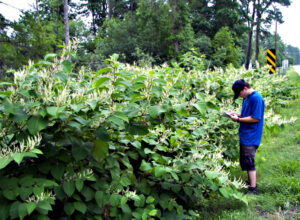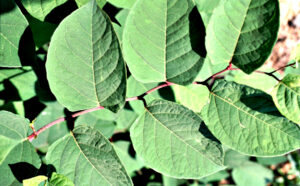
Species in the knotweed complex grow very quickly, causing large infestations on roadsides like this one. / Photo Credit: Randy Westbrooks, Invasive Plant Control, Inc., Bugwood.org
By Wisconsin DNR
With the scourge of knotweed about to gear up for another growing season, the Wisconsin Department of Natural Resources (DNR) is offering information.
The DNR has created two fact sheets to instruct general and urban landowners on the best control methods for the fast-growing invasive plant.
One is meant to inform landowners in urban settings; the other is directed toward landowners in nonurban areas.
Separate fact sheets are offered because urban and nonurban landowners face different herbicide regulations.

The leaves of Japanese knotweed have a spade-like shape and are squared off at the base. / Photo Credit: John Cardina, The Ohio State University, Bugwood.org
Sometimes referred to as “the knotweed complex,” Wisconsin has three regulated species of knotweed: Japanese knotweed, giant knotweed and a hybridization known as Bohemian knotweed. Each has been found in the state.
Knotweeds are extremely quick-growing plants that can cause considerable damage and are difficult to control. While novice gardeners may jump at the opportunity to plant what they’ve heard is easy to grow, the benefits of planting a knotweed species do not outweigh the risks.
Due to the complexity and invasive nature of knotweed species, research into effective control methods has played a prominent and ongoing role. While numerous resources are available, they often present varying recommendations, some of which may not reflect the most current scientific findings.
To address this inconsistency, members of the Forest Health Team have compiled and reviewed a range of materials, comparing them with the latest research on knotweed control, and inviting input from professionals in adjacent states.
The DNR fact sheets offer tips for identifying and controlling knotweed populations on their land. They also include links to other documents with more specialized information.
If you suspect you’ve found knotweed on your property, send photos and specific locations using GPS points, street addresses or road crossings to Invasive.Species@wisconsin.gov.
